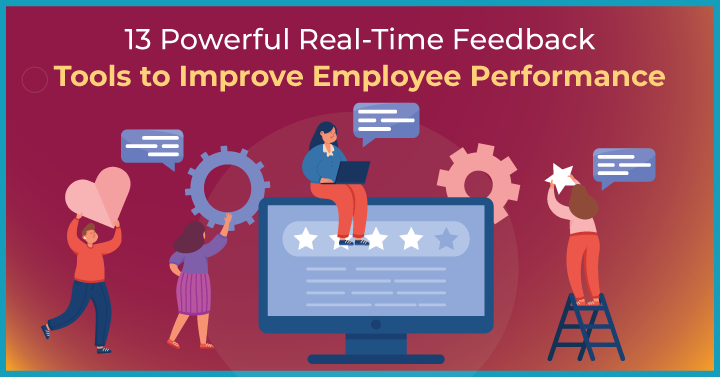Real-time feedback tools take the hassle out of reviewing employee performance. Rather than relying on regular Excel sheets or Word docs, you can instead upgrade to a platform that presents a professional, straightforward interface for collating information and providing data analysis.
Whether your focus is on keeping employees engaged or driving goal-based achievement, here are some of the top solutions to consider for your company.
1. What Are Real-Time Feedback Tools and Their Importance?

Real-time performance feedback tools allow companies to monitor objectives and promote continuous development in their staff. By maintaining ongoing dialog regarding development and satisfaction, these regular reviews help to improve employee engagement and performance, create a culture of recognition, and foster ongoing learning and development.
2. Overview of 15 Real-Time Feedback Tools
- 6Q – Best for an Efficient Feedback Mechanism with Minimal Complexity
- Culture Amp – Best for a Multifaceted Approach to Employee Evaluation
- Lattice – Best for Automating Feedback Cycles
- TINYpulse – Best for Building a Positive Review Environment
- WeekDone – Best for OKR Setting and Tracking
- Reflektive – Best for Assessing Employee Growth and Potential
- 15Five – Best for Transparent Discussions around Expectations and Evaluations
- Engagedly – Best for Integrating with Popular HRIS
- Sprynkl – Best for Informal Employee Polls
- Spidergap – Best for Pure 360-Degree Feedback without Frills
- Hi5 – Best for Building a Recognition Culture
- SurveyMonkey – Best for Easy-to-Build Surveys
- SurveySparrow – Best for Data-Backed Performance Assessment
3. Comparison Criteria
3.1 User Interface
The optimum user interface should combine pleasing aesthetics with an intuitive design that facilitates the usage of the software.
3.2 Ease of Use
Ease of use is important because it means less resources are required to train someone in how to utilize a program, in addition to less time engaging customer support.
3.3 Integrations
Most companies these days run multiple tools with different functionalities. Making sure anything you purchase integrates with your existing systems will lead to greater company efficiencies.
3.4 Price
Cost is something that almost always features into any procurement decision. It’s important to weigh up what you can afford against the depth of capabilities you require.
4. Must-Have Features of Real-Time Feedback Tools
4.1 Offers Actionable Information
A real-time feedback tool is only useful if it presents relevant qualitative and/or quantitative data that can help managers decide how to improve employee performance.
4.2 Aids in Performance Reviews
Having all the key information at your fingertips makes it much easier and less time intensive to have meaningful performance reviews that lead to tangible results.
4.3 Able to Set Milestones
Rather than trying to track incremental goals in Excel sheets or Word documents, you can utilize a digital tool with a more visually impactful display, so that both employer and employee can keep tabs on the key milestones.
4.4 Seamlessly Integrate with Collaboration Tools
Being able to build real-time feedback into your existing systems makes the whole process much easier for everyone to communicate and stay on track, from managers, to staff, to HR.
4.5 Can Streamline Workflow
If everything is well integrated, regular feedback should be a breeze to implement into your workflows, so that there’s neither friction with day-to-day tasks nor the need for seismic behavioral change.
5. Best Real-Time Feedback Tools to Gauge Employee Performance 2022
5.1 6Q – Best for an Efficient Feedback Mechanism with Minimal Complexity

As the name implies, 6Q’s USP is that it delivers actionable feedback through employee surveys of just 6 questions every 1, 2, 4 or 13 weeks. Keeping things simple is a cornerstone of the platform, as evidenced by its clean UI and ease of use.
6Q estimates that most of its surveys – whether from the existing library or custom made – take less than 2 minutes to answer, meaning they occupy little employee time. The responses are then presented in readily comprehensible graphs or figures, which can be benchmarked against more than 1,900 other organizations globally.
Prices start at $99 per month for teams of up to 50 users, including unlimited segmentation of employees by such aspects as role type or achievement.
5.2 Culture Amp – Best for a Multifaceted Approach to Employee Evaluation
Culture Amp offers modules for employee engagement, performance management and employee development. The complete platform incorporates surveys, OKR tracking and personalized growth plans to drive ongoing improvements, both in managers and staff.
All of this is backed up by an analytics element that assesses employee sentiment, goal completion rates and turnover. Plus, it all integrates with common collaboration tools like Slack and Microsoft Teams as well as HR software like SAP SuccessFactors and BambooHR.
Prices are available on request, though even the most basic package accommodates companies of 25 to 200 employees.
5.3 Lattice – Best for Automating Feedback Cycles
Continuous feedback forms part of Lattice’s performance management and OKR management suite, with the option to add on extras like engagement surveys or growth plans.
The software allows for project-based or 360-degree reviews, which can be delivered by, or requested from, an individual’s managers or peers. These can be automated to take place every few weeks or months and tagged according to things like ‘performance issues’ or ‘retention risk.’
Prices start at $11 per person per month, including integrations with Jira and Salesforce.
5.4 TINYpulse – Best for Building a Positive Review Environment
Through TINYpulse’s straightforward UI, managers can instantly review anonymous survey results, 1-on-1 sessions, employee goals and 360-degree feedback at the click of a button.
The company’s principal focus is on engagement, such as through its Cheers for Peers concept, which encourages a positive work culture through recognizing achievements.
Prices are available on request, with integrations for Slack, Microsoft Teams and email accounts delivered as standard.
5.5 WeekDone – Best for OKR Setting and Tracking
Objectives and key results are the backbone of WeekDone, which boasts a colorful, informative dashboard that summarizes how a team is performing at a glance.
Custom email, PDF or Excel reports can be set up to ensure managers are always on top of goal progress, and there are also a whole bunch of resources dedicated to educating people on OKR best practices. Bear in mind, however, that in-built feedback functionality is very limited.
Prices start from $90 per month for a 10-user package, though there are free feedback tools for employees of three or fewer. Integrations available include Zapier, MS Teams, Google Sheets, Asana and Jira.
5.6 Reflektive – Best for Assessing Employee Growth and Potential
Integrating with communication tools (Gmail, Slack, MS Office) as well as HRIS (Workday, ADP, BambooHR), Reflektive includes such in-built functionality as goal tracking, 1-on-1 feedback conversations, peer-reviews and a data analysis platform.
The Calibration feature makes it easier to segment staff from a talent-management perspective, while the engagement surveys track sentiment all along the employee lifecycle.
Prices are available on request.
5.7 15Five – Best for Transparent Discussions around Expectations and Evaluations

15Five’s real-time feedback can accommodate OKR progress reports, weekly check-ins, employee requests for performance notes and peer reviews. The robust interface also includes a section where managers and their teams can together define roles and expectations, as well as create vision boards for career progression.
Integrations are available for common HRIS, Jira, Salesforce, Slack, MS Teams and Google Calendar, depending on the package.
Prices start from $4 per person per month for the basic employee engagement solution, rising to $8 for OKR setting and feedback functionality.
5.8 Engagedly – Best for Integrating with Popular HRIS
Based around the three pillars of performance, development and engagement, Engagedly’s platform comes with free online courses, webinars and case studies, so you can make the most of its capabilities.
Its real-time feedback tools for managers make it easy to share positive or constructive criticism at any time, alongside more structured reviews over 30-, 60- or 90-day periods. This can be complemented with Engagedly’s mentoring platform and LMS.
Prices start from $6 per user per month, with integrations available for ADP, Namely, BambooHR, Personio, Gusto, Slack and several security applications.
5.9 Sprynkl – Best for Informal Employee Polls

Describing itself as a private social network for every team, Sprynkl is a free tool for employees that encompasses posts, comments and party games.
From a real-time feedback perspective, it allows managers to conduct polls and send open questions, in order to get information to improve engagement. This can be done anonymously to encourage free and open dialog.
While still available from app stores, Sprynkl now operates as part of Grove HR.
5.10 Spidergap – Best for Pure 360-Degree Feedback without Frills
Spidergap is a relatively simple software that facilitates the creation of questionnaires for 360-degree reviews. Answers are then translated into actionable data points.
While it’s not the prettiest UI, it is simple to set up and receive reports, with templates and clear instructions on how to build a feedback workflow. Just don’t expect any integrations with other software.
Prices start from $989 per year.
5.11 Hi5 – Best for Building a Recognition Culture
The core concept of Hi5 is that it allows members of a team to give each other virtual high-fives for a job well done, complemented by games to lend a fun atmosphere to the product.
On a more practical level, businesses can conduct pulse surveys and compile digestible reports based on the real-time feedback, whether the purpose is to assess KPIs or staff sentiment. Additionally, it has an open API and integrations with Apple like Slack to WhatsApp.
Prices start from $1 per user per month purely for the social aspect, rising to $4 for the full business package.
5.12 SurveyMonkey – Best for Easy-to-Build Surveys
SurveyMonkey is a broad surveying tool but also provides a platform for real time feedback activities. You can use it to create questionnaires for all sorts of use cases in both the consumer and business sphere.
Its popularity stems from ease of use: the solution provides templates that can be customized according to your company’s requirements, with 360-degree reviews and career training feedback among the pre-built options.
Prices start from $32 per user per month, including free integrations with popular collaboration apps as standard.
5.13 SurveySparrow – Best for Data-Backed Performance Assessment

As with SurveyMonkey, SurveySparrow is one of the employee feedback tools that focus on the questionnaire aspect of real-time reviewing. Compare self-assessments with peer assessments and managerial reviews to get an omnidirectional picture of an individual’s work performance, which you can then benchmark against other companies.
The platform’s competency summary makes it easy to identify areas where a member of staff is succeeding and where they may need further training or other forms of intervention.
Prices start from $99 for the basic business suite, which features white labeling and integration with a good number of other tools, including Monday, HubSpot, Slack, Google Analytics, Microsoft Teams and Zendesk.
6. FAQs
- Why Do Employees Need Performance Feedback?
Performance feedback can improve the engagement and efficacy of an employee, while also giving them a forum to express any concerns they have or L&D they might require.
- How Can Real-Time Feedback Process Help an Employee Be More Effective?
By creating a continuous flow of feedback, companies can ensure all staff are on course to meet their OKRs, while managers are able to more rapidly troubleshoot any issues that arise than would normally be possible with less frequent evaluation schedules.
 Interested in Virtual Team Building Events?
Interested in Virtual Team Building Events?





















